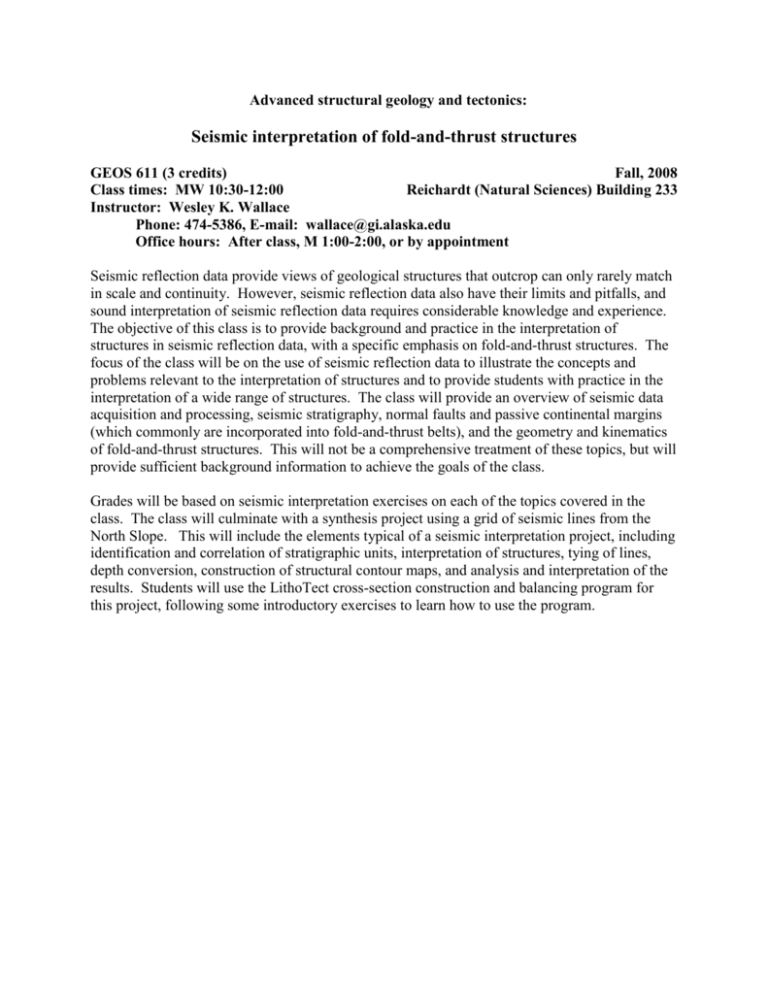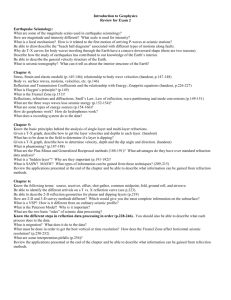Advanced structural geology and tectonics:
advertisement

Advanced structural geology and tectonics: Seismic interpretation of fold-and-thrust structures GEOS 611 (3 credits) Fall, 2008 Class times: MW 10:30-12:00 Reichardt (Natural Sciences) Building 233 Instructor: Wesley K. Wallace Phone: 474-5386, E-mail: wallace@gi.alaska.edu Office hours: After class, M 1:00-2:00, or by appointment Seismic reflection data provide views of geological structures that outcrop can only rarely match in scale and continuity. However, seismic reflection data also have their limits and pitfalls, and sound interpretation of seismic reflection data requires considerable knowledge and experience. The objective of this class is to provide background and practice in the interpretation of structures in seismic reflection data, with a specific emphasis on fold-and-thrust structures. The focus of the class will be on the use of seismic reflection data to illustrate the concepts and problems relevant to the interpretation of structures and to provide students with practice in the interpretation of a wide range of structures. The class will provide an overview of seismic data acquisition and processing, seismic stratigraphy, normal faults and passive continental margins (which commonly are incorporated into fold-and-thrust belts), and the geometry and kinematics of fold-and-thrust structures. This will not be a comprehensive treatment of these topics, but will provide sufficient background information to achieve the goals of the class. Grades will be based on seismic interpretation exercises on each of the topics covered in the class. The class will culminate with a synthesis project using a grid of seismic lines from the North Slope. This will include the elements typical of a seismic interpretation project, including identification and correlation of stratigraphic units, interpretation of structures, tying of lines, depth conversion, construction of structural contour maps, and analysis and interpretation of the results. Students will use the LithoTect cross-section construction and balancing program for this project, following some introductory exercises to learn how to use the program. Fold and thrust structures (GEOS 611) W.K. Wallace Tentative outline of topics to be covered Background information and concepts The process of interpretation of seismic reflection data Acquisition and processing of seismic reflection data Stacking Migration Depth conversion Geophysical artifacts Seismic stratigraphy Geometry of clastic deposits Geometry of carbonate deposits Salt Normal faults Passive continental margins Folds Faults Thrust-related folds Fault-bend folds Detachment folds Fault-propagation folds Shear fault-bend folds Breakthrough of thrust-related folds Growth stratigraphy in thrust-related folds Thrust systems Imbricate fans Duplexes Wedge structures and triangle zones Final project: Seismic interpretation of the Kavik area LithoTect cross-section construction program Kavik area seismic reflection grid Fall, 2008 Syllabus, page 2






